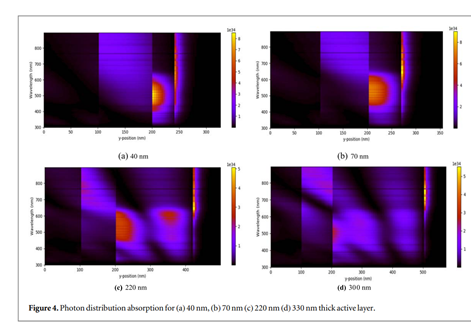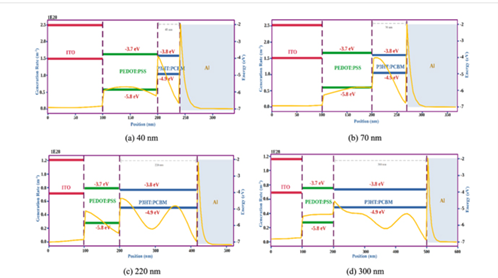
High Efficiency Solar Cells Using Wide Bandgap Organic Materials
Objective/Contributions:
Egypt faces a major problem in providing adequate amounts of energy from oil and natural gas. These two non-renewable sources of energy contribute to 95% of the total energy resources needed for generating electricity. Although Egypt has a reserve in these primary sources, there is a shortage in demand due to fast utilization and the increased cost of extraction. According to the Egyptian energy strategy for 2030 and its update to 2035,'' It is expected that Egypt will be a net importer of oil and natural gas within ten (10) years from the start of the third decade of this century". This represents a further challenge for the Egyptian economy due to price fluctuations in the international energy business; this fluctuation will be difficult to control. As a result, Egypt should work on diversifying energy resources to maximize the payback of using local resources such as renewable resources including solar energy.
Organic photovoltaic or solar cells are promising solar-cell generation of energy because of the abundance of their constituent elements and base materials, their low cost, and their relative ease of chemical synthesis; moreover, massive fabrication of related materials has been applied and constitutes an established and robust technology. Additionally, organic solar cells can be prepared on plastic foil, making them ideal candidates for flexible and portable systems.
This work focuses on photovoltaic cell research using organic material. But our advances in understanding and selecting the best materials and processes will be applied to achieve the best performance.
- Tailoring several WBG materials into tandem solar cells to improve the optoelectronic properties and enhance the cell’s efficiency.
- Addition of the conjugated polymer layer with nano-additives (i.e. nano-polymeric layer) such as Graphene-Fullerene.
- Modelling by computer software (e.g. Comsole Multiphysics or Lumerical).
- The tandem solar cell will be designed and fabricated with the WBG materials on a Si substrate by a mean of physical deposition techniques.
Outcome:
- Compromising and optimization of the designed tandem solar cells the various features of both the WBG semiconductors and the nano-polymeric layers will be accomplished.
- A computer modelling (i.e. simulation), designing and characterization of the designed tandem solar cells will be performed after optimization to determine the optimal designs and results
- polymeric layers using computer modelling software.
- Simulating the electrical and optical properties of the designed tandem solar cells.
- Simulating the coupling heat transfer/ electromagnetic waves with the semiconductor.
- Designing and fabrication of the tandem solar cells with the optimized results of both the WBG and nano-polymeric layers.
- Characterization of the electrical and optical properties of the optimized tandem solar cells.
- Evaluation of the physical properties of the optimized solar cells.
- Fabricate a prototype of tandem solar cells.
Outcome: Publications:
- Review organic solar cells parameters extraction and characterization techniques Zidan, M.N., Everitt, N., Ismail, T., Fahim, I.S. Polymers, 2021, 13(19), 3224
- Effect of thickness and temperature on flexible organic P3HT:PCBM solar cell performance Zidan, M.N., Ismail, T., Fahim, I.S. Materials Research Express, 2021, 8(9), 095508
- Develop TE/TM Pass Filters on double-loaded-on-ridge Structure with ITO/TiN for Upstream FTTH Optical Access Networks Ismail, T., Emad, A., Pal, K., Fahim, I. Journal of Molecular Structure, 2021, 1228, 129727
- Conference Paper Tandem Organic Solar Cell Optimization Using Response Surface Methodology Mohammed, A.R., Fahim, I.S. 2020 International Conference on Data Analytics for Business and Industry: Way Towards a Sustainable Economy, ICDABI 2020, 2020, 9325624\
- Conference Paper Modified P3HT:PCBM Active Material with LiF Vertical Cylinders for Organic Solar Cells Emad, A., Mahmoud, H., Fahim, I.S., Ismail, T. 2nd Novel Intelligent and Leading Emerging Sciences Conference, NILES 2020, 2020, pp. 171–174, 9257947
- 1D (1-Dimensional) Si P-N Junction with Organic Materials and Transparent Conductive Oxides (TCOs) Alternatives Emad, A., Rashad, A.R., Fahim, I.S., Ismail, T. 2020 IEEE PES/IAS PowerAfrica, PowerAfrica 2020, 2020, 9219815
- Enhancement of Organic Solar Cells Through Macroscopic and Microscopic Models Mahmoud N. Zidan, Tawfik Ismail, Sally S. Kassem, Hayam G. Wahdan & Irene S. Fahim Topics in Catalysis (2022)

